Flipped-Exponential Nyquist Pulse Techniqueto Optimize PAPRin Optical Direct-Detection OFDMSystems
Jiangnan Xiao,Zizheng Cao,Fan Li,Jin Tang,and Lin Chen
(Hunan University,Changsha 410082,China)
Abstract In this paper,we describe a novel technique based on the flipped-exponential(FE)Nyquist pulse method for reducing peak-to-average power ratio(PAPR)in an optical direct-detection orthogonal frequency-division multiplexing(DD-OFDM)system.The technique involves proper selection of the FENyquist pulses for shaping the different subcarriers of the OFDM.We apply this technique to a DD-OFDM transmission system to significantly reduce PAPR.We also investigate the sensitivity of a received OFDM signal with strong nonlinearity in a standard single-mode fiber(SMF).
Keyw ords optical fiber communication;orthogonal frequency-division multiplexing(OFDM);flipped-exponential Nyquist pulse;PAPR
1 Introduction
O rthogonalfrequency-division multiplexing(OFDM)is widely used in wireless communications and has also been considered for use in fiber-optic systems[1]-[10].The reason OFDM has been applied to opticalcommunications is that it is extremely tolerant to chromatic dispersion(CD)[1]-[10].However,one inherent defect of optical OFDM is its high peak-to-average power ratio(PAPR)[11],[12].Because of this,an optical OFDM signalhas high nonlinearity in the transmission fiber.In addition,if the PAPRis too high,a Mach-Zehnder modulator(MZM)and digital-to-analog/analog-to-digital(DAC/ADC)converter will also introduce high nonlinearity.Therefore,reducing the PAPRof the OFDM signal is an urgent issue.Many techniques have been developed to reduce PAPR,including selective clipping,coding,scrambling,and companding.However,most of these cause signal distortion or redundancy,which results in increased need for transmission bandwidth.In this paper,we propose and experimentally demonstrate optical direct-detection OFDM(DD-OFDM)that uses the flipped-exponential(FE)Nyquist pulse technique.This can reduce the PAPRof the OFDM signal without affecting bandwidth efficiency,and it does not close off the possibility of using other techniques for channel protection.Increasing spectral efficiency(SE)is essential for future large-capacity optical transmission systems and networks.Several industry research proposals on spectrally efficient channel multiplexing and filtering techniques,such as optical OFDM and Nyquist-WDM,have been put forward[13]-[15].
In the proposed system,we study the transmission of 2.5 Gbit/s QPSK-OFDM signals over 100 km single-mode fiber(SMF).The FENyquist technique is used for transmission.
2 Principle of Operation
2.1 OFDM System with FENyquist Pulse Technique
Fig.1 shows an intensity-modulation and direct-detection(IM-DD)OFDM transmission system with FENyquist pulse technique.PAPRof the OFDM signals can be reduced if the subcarrier waveforms have different shapes[6].We choose the FENyquist pulse.The FENyquist pulse technique is used to reduce PAPRof the OFDM signal,and its pulse shapes are very flexible and can control the correlation between the OFDM block samples without destroying orthogonality between the subcarriers of the modulated OFDM signal.
2.2.OFDM System Model with FE Nyquist Pulse Technique
Fig.2 shows the transmitter schematic.The incoming signal is modulated on baseband by using a bandwidth-efficient modulator.
The totalnumber of orthogonal subcarriers is N.The baseband modulated stream has a data rate 1/T,where T is the symbolduration,and is split into N parallel streams.Each stream is shaped by a time waveform and is transmitted over a subcarrier.The equivalent transmitted OFDM signal can be written as

where anis the modulated data symbol of the n th subcarrier.The waveform pn(t)is the pulse shape,which has duration T at subcarrier fiand has a bandwidth less than or equal to the bandwidth of the OFDM signals s(t)To maintain orthogonality of the subcarriers,the shaping pulses pi(t)should have the following properties[16]:

The PAPRof the OFDM signalis given by

The summing of the in-phase orthogonal frequencies causes high PAPR.A possible way of reducing this PAPRis to correlate the different OFDM samples of the same block.By making cross-correlation close to one,a multicarrier signal with very low PAPRis obtained.The cross-correlation function of the OFDM signalis

The autocorrelation function is a function of the modulated signal symbol and the subcarrier waveforms.Therefore,increasing the correlation between the OFDM signal samples at the same block can be achieved with these two parameters.If the pulse shape is different,the cross-correlation function is

Thus,shaping the different subcarriers using the same pulse shape increases the peak amplitude of the transmitted signal without affecting the correlation properties between the different samples.If the pulse shape is different,the cross-correlation function is

Thus,a proper selection of the subcarrier time waveforms increases the cross-correlation function and reduces PAPR.A set of broadband pulse waveforms was proposed in[6]to reduce PAPR.We define the following set of Nyquist pulses:

where t-τm-n=[(m-n)mod N]Ts.Then,
This shows that the different subcarriers using the set of FE Nyquist pulses shapes do not increase the peak amplitude of the transmitted signal.The peak amplitudes of the different waveforms shaped by the FENyquist pulse set,which is formed according to(1),do not occur at the same time.This is also the ISI-free property of a Nyquist pulse.
An FENyquist pulse is specified by the frequency spectrum[17],[18]:
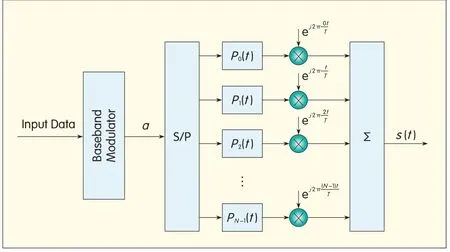
▲Figure 2.OFDMscheme based on pulse shaping.
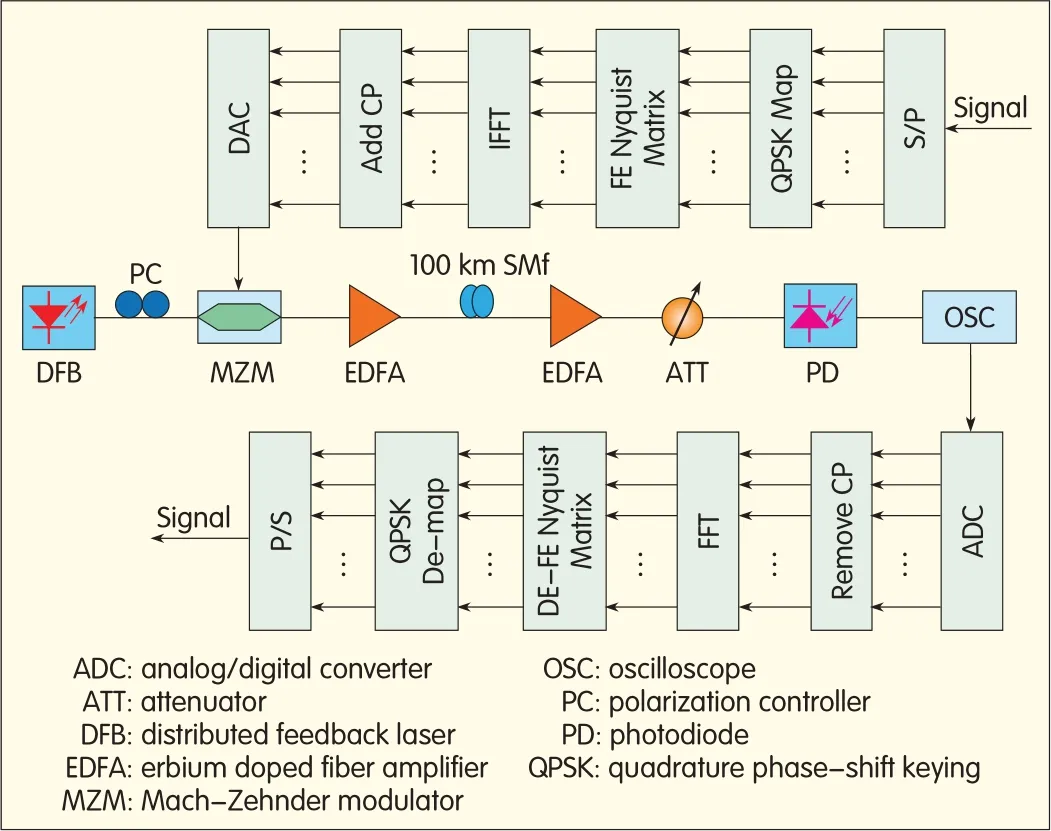
▲Figure 1.Intense modulation and direct-detection(IM-DD)OFDMtransmission system with FENyquist pulse technique.
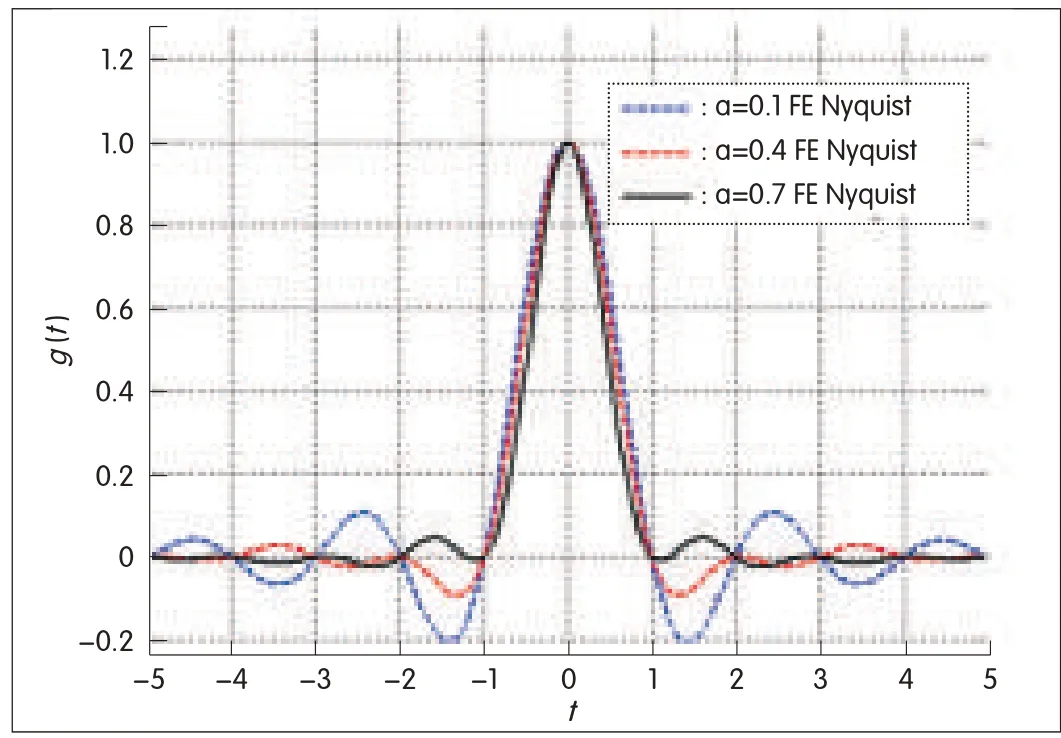
▲Figure 3.Impulse response of FENyquist pulses.

▲Figure 4.Frequency response of FENyquistpulses.


where B is the bandwidth that corresponds to the symbol repletion rate T=1/(2B).The roll-off factor isα.
Fig.3 and Fig.4 show the impulse and frequency response of FENyquist pulses with differentαrespectively.These pulses are real,even,and ISIfree with optimal time sampling.Furthermore,the FENyquist pulses asymptotically decay as tnand the amplitude of the main side lobes decrease and as the roll-off factorαincreases.
Fig.5 shows the shape of these subcarrier waveforms for N=16 andα=0.7.This set of waveforms reduces PAPRof the OFDM signal because the peak amplitudes of the waveforms do not occur at the same time.This is also the ISI-free property of the Nyquist pulse and shows that each FENyquist pulse is orthogonal to each other.Fig.6 shows the corresponding spectrum.
Fig.7 shows the complementary cumulative distribution functions(CCDFs)of the original OFDM and OFDM with FE Nyquist.Our proposed method reduces peak power more than conventional OFDM.The reason why more PAPRis reduced with a larger roll-off factor is because the magnitude of the side lobe of a Nyquist pulse is smaller with a larger roll-off factor.The improvement on original OFDM is 1.9 d B for α=0.1,2.4 d B forα=0.4,and 2.9 d B forα=0.7 when CCDF is 1×10-4.
3 Experimental Setup and Results
In this experiment,the number of OFDM subcarriers is 256.Of these subcarriers,192 are used for data;8 are used for pilots;and 56 are used for guard intervals.The cyclic prefix is 1/8 of the OFDM symbol duration,which is 32 samples in each OFDM frame.QPSK is used for the subcarrier modulation scheme.The OFDM signal is generated offline
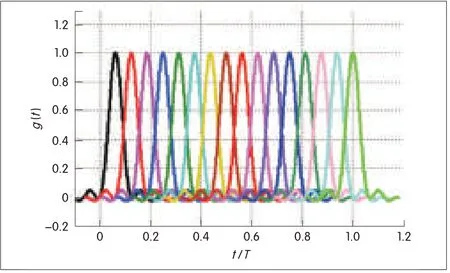
▲Figure 5.The new set of waveforms with FENyquist as the main pulse for N=16 subcarriers.
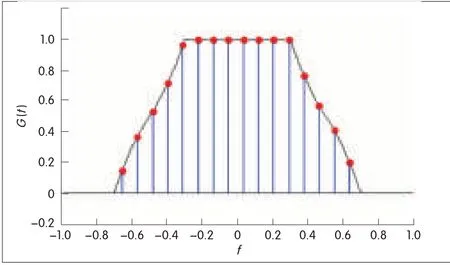
▲Figure 6.The spectrum with FENyquist pulse for N=16 subcarriers.
The corresponding impulse responses are and uploaded into an arbitrary waveform generator(AWG).The waveforms produced by the AWG are continuously output at sample rate of 2.5 GSa/s.In the receiver,we use Matlab to process a waveform recorded by a real-time oscilloscope.
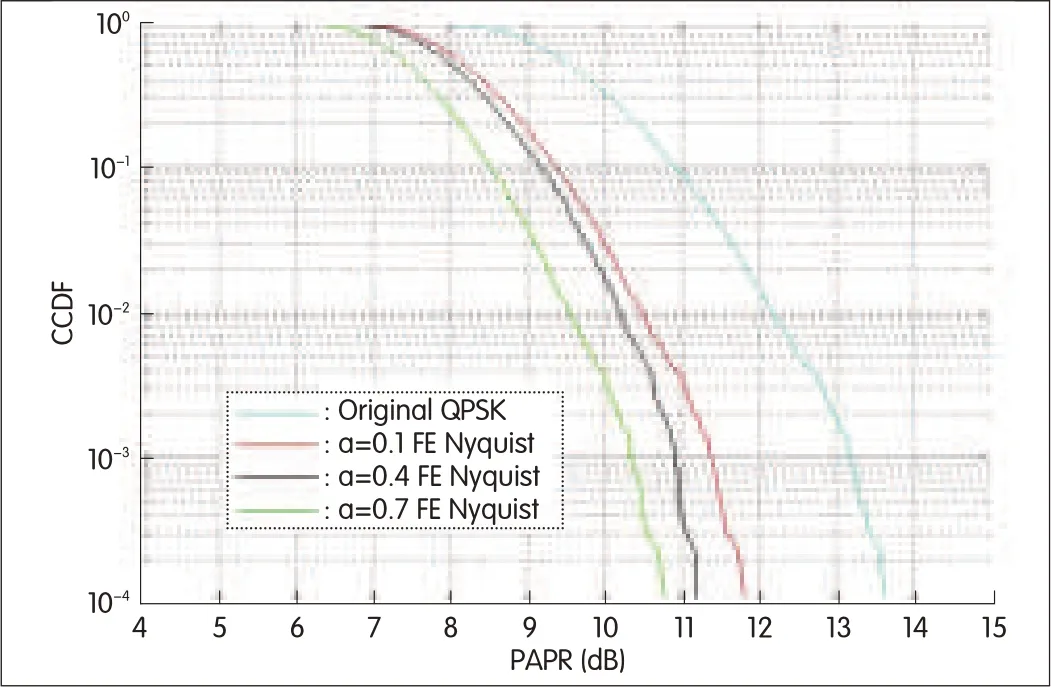
▲Figure 7.CCDFof conventional OFDMand OFDMwith transmission FENyquist pulse technique.
There are two types of OFDM signals in this experiment:original QPSK-OFDM signaland OFDM signal with FENyquist.We measure the BER of the OFDM signals at different power levels into the transmission fiber.
Fig.8(a)shows the waveforms of the original OFDM signal.Fig.8(c),(e),and(g)shows the OFDM signal with FENyquist whenα=0.1,0.4,and 0.7,respectively.The waveforms of the FE Nyquist OFDM signal are have a smaller range than those of the original OFDM signal.Moreover,the range becomes smaller as increases.
Fig.4(b)shows the spectra of the original OFDM signal.Fig.4(d),(f),and(h)shows the FENyquist OFDM signal whenα=0.1,0.4,and 0.7,respectively.Spectral broadening is clearly observed,and this broadening is introduced when a larger roll-off factor is used.Fig.9 shows thatαsignificantly affects BER,because a large can greatly decrease ICIpower and dramatically improve BER.The signal is transmitted over 100 km standard SMF,and the launch power is-2 d Bm.For the 2.5 Gbit/s FE Nyquist OFDM signaltransmitted over 100 km standard SMF,the receiver sensitivity at BER=10-4is 2 d B,1.5 d B,and 1 d Bbetter than that of OFDM without FENyquist whenα=0.7,0.4,and 0.1,respectively.Because it uses a unity roll-off factor,the new method outperforms original schemes.
Fig.10 shows the BERof the FENyquist OFDM signal transmitted 100 km standard SMFwith a launch power of 3 d Bm.It also shows that the BER of the FENyquist OFDM signal improves asα increases.However,the BERof the FENyquist OFDM signal with launch power of 3 d Bm is better than that of the FENyquist OFDM signal with launch power of-2 d Bm.The receiver sensitivity at BER=10-4over 100 km SMFtransmission is 3 d B,2 d B,and 1 d B better than that of the OFDM signal without FENyquist whenα=0.7,0.4,and 0.1,respectively.
Fig.11 shows the BERof the FENyquist OFDM signal transmitted over 100 km standard SMFwith a launch power of 8 d Bm.It also shows that the BERof the FENyquist OFDM signal improves asαincreases.However,the BERof the FE Nyquist OFDM signalwith launch power of 8 d Bm is better than that of the FENyquist OFDM signal with a launch power of-2 d Bm or 3 d Bm.The receiver sensitivity at BER=10-4100 km SMFtransmission is 3 d B,2 d B,and 1d B better than that of the OFDM signal without FENyquist whenα=0.7,0.4,and 0.1,respectively.
Fig.12 shows the BERof the FENyquist OFDM signalwhen α=0.7.The signal is transmitted over 100 km standard SMF transmission,and the launch power is-2,3,and 8 d Bm.The received optical power of FENyquist OFDM withα=0.7 at BER=10-4.5is-24 d Bm,-23 d Bm,and-20 d Bm for launch powers of 8 d Bm,3 d Bm,and 2 d Bm,respectively.However,the required opticalpower of the original OFDM signal at BER of 10-4is-20.5 d Bm,-20 d Bm,and-18d Bm for 8 d Bm,3 d Bm,and-2 d Bm launch powers,respectively.Fig.12 shows that the receiver sensitivity significantly increases for the FENyquist OFDM signal whenαremains the same and the launch power increases.

▲Figure.8 Spectra and waveforms of the original OFDMsignal and OFDMsignal with FENyquist pulses technique whenα=0.1,0.4 and 0.7,respectively,over 100 km SMF.
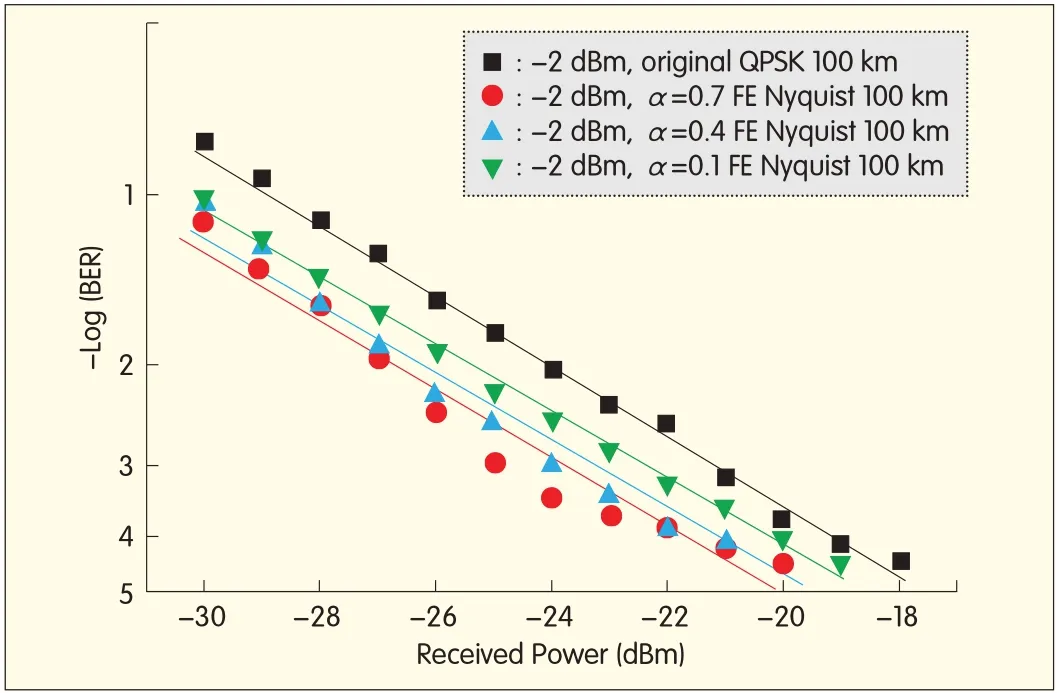
▲Figure 9.BERcurves for OFDMsignalwith FENyquistpulse whenα=0.1,0.4,0.7 and fiber launch power is 2 dBm.

▲Figure 11.BERfor OFDMsignalwith FENyquistpulse when α=0.1,0.4,0.7 at 8 dBm fiber launch power.
4 Conclusion
We have proposed a novel PAPRreduction method for optical DD-OFDM systems.The flipped-exponential Nyquist pulse technique is experimentally shown to be effective in reducing the PAPRin an OFDM system.Our proposed technique is very effective and flexible for any number of carriers.We have analyzed the BERof an FENyquist OFDM signalwith different roll-off factorsα.The signal was transmitted over 100 km SMFwith fiber launch powers of-2 d Bm,3 d Bm,and 8 d Bm.
These experimental results show that the BERof an OFDM signal with FENyquist pulse technique improves whenα increases and the launch power stays the same.The receiver sensitivity at BER=10-4after 100 km SMFtransmission is 2 d B,1.5 d B,and 1 d B better than that of the original OFDM signalwhenα=0.7,0.4,and 0.1,respectively,and when the fiber launch power is-2 d Bm.The receiver sensitivity is 3 d B,2 d B,and 1 d B better than that of the original OFDM signal whenα=0.7,0.4,and 0.1,respectively,and when the launch power is 3d Bm.The receiver sensitivity is 3 d B,2d B,and 1 d B better than that of the original OFDM signal whenα=0.7,0.4,and 0.1,respectively,and when the launch power is 8 d Bm.Moreover,the receiver sensitivity significantly increases for the FENyquist OFDM signal when the roll-off factor remains the same and the launch power increases.These experimental results show that the FENyquist pulse technique efficiently improves the performance of an IM-DD optical OFDM system.Using the technique,the BERand receiver sensitivity of optical OFDM are better than the BERand receiver sensitivity of the original optical OFDM,which does not use the technique.

▲Figure 10.BERfor OFDMsignal with FENyquist pulse when α=0.1,0.4,0.7 and fiber launch power is 3 dBm.

▲Figure 12.BERfor an OFDMsignalwith FENyquistpulse when α=0.7 at different launch powers.
Acknowledgements
This work has been partly supported by the National Science Foundation of China(Grant Nos.60977049),the National“863”High Tech Research and Development Program of china(Grant No.2009AA01Z220,2009AA01Z222),Program for Hunan Provincial Science and technology.
- ZTE Communications的其它文章
- 100Gand Beyond:Trends in Ultrahigh-Speed Communications(Part II)
- FSKModulation Scheme for High-Speed Optical Transmission
- Computationally Efficient Nonlinearity Compensation for Coherent Fiber-Optic Systems
- 100 Gbit/s Nyquist-WDM PDM 16-QAM Transmission over 1200 km SMF-28 with Ultrahigh Spectrum Efficiency
- Field Transmission of 100Gand Beyond:Multiple Baud Ratesand Mixed Line Rates Using Nyquist-WDMTechnology
- Open Augmented Reality Standards:Current Activities in Standards-Development Organizations

